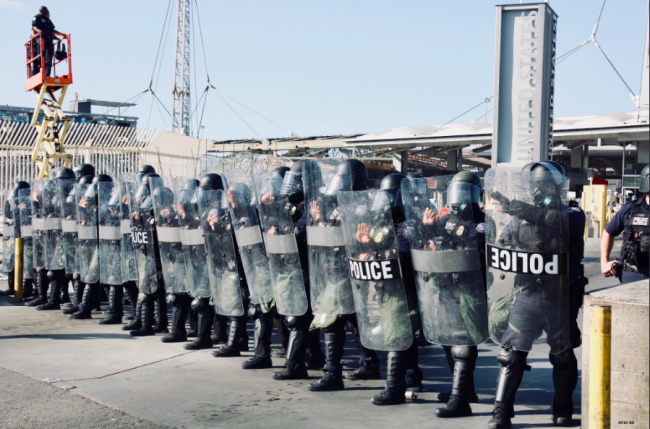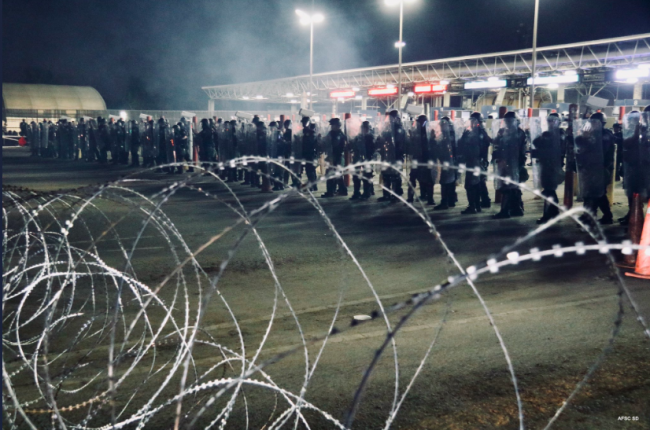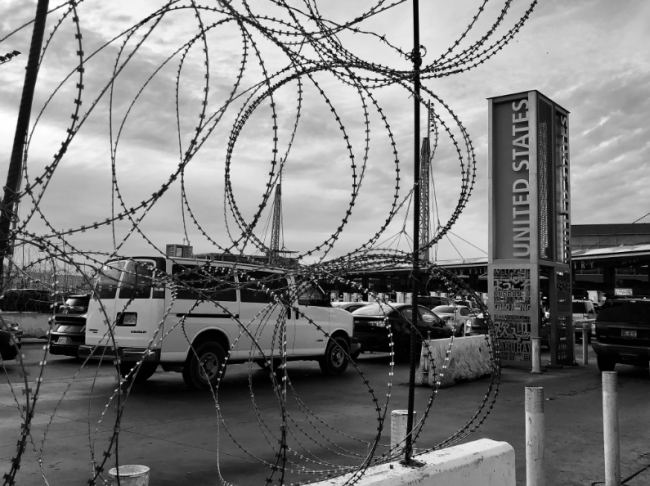
On January 20, the Otay Mesa-Tijuana Port of Entry, one of the busiest port of entry in the world, shut down for about 15 minutes. During this time, hundreds of CBP officers in riot gear stood in formation and marched towards the vehicle lanes, occasionally yelling threats in unison, as is typical during border shutdowns. However, this time they blocked entry using concertina wire and shot tear gas. A video of the event shows what sounds like explosives detonating in the background. Throughout the exercise, the following message was played on loop: “CBP is currently conducting an exercise. We will continue to process traffic shortly. Thank you for your patience.” The true message, however, was clear: CBP was attempting to make the border as hostile as possible by preparing to use force, possibly lethal, against refugees at any moment. At various Mexico-U.S. land ports of entry, the U.S. government is normalizing excess militarization through the presence of armed CBP officers in riot gear, barricades, and concertina wire installed by the military, as well as never-ending surveillance from DHS helicopters. These drastic changes are evident from government spending records, where CBP purchased $108,464 worth of ammunition specifically for caravan efforts, $16,906 went to the emergency purchase of riot gear in response to the Central American Caravan.
Similar operations have occurred at other ports of entry, including the most recent shutdown on February 22 at the Las Americas bridge in the Ciudad Juárez-El Paso region, where CBP installed new barricades a week after Trump declared a ‘national emergency’ at the border. Using the same false logic that justified other shutdowns, CBP announced that it was preparing for a migrant rush at the border. This justification brings to mind the images of so-called “Banzai Runs,” employed by staunch anti-immigration California governor Pete Wilson during his 1996 reelection campaign. Like Wilson, Trump has continued to aggressively advance the crisis narrative in order to receive funding to increase border security to build a wall.
Since the arrival of the Central American migrant exodus in late 2018, the number of border closures at official Ports of Entry have increased. This has turned what was already long, tedious, and stressful border experience into a dystopian experience resembling entering a war zone not only for asylum-seekers but for members of the transborder community who regularly cross the border.
Obscured from this spectacle of border closure is the inconvenient truth behind the U.S.-generated crisis, stemming largely from the illegal ‘metering’ or push-back practices, which place an artificial restriction on the number of asylum-seekers allowed to cross into the United States to begin the process of applying for asylum. This practice relies on CBP officers denying entry to asylum seekers through intimidation tactics, providing false information, physically obstructing them, or telling them that they have reached capacity. Furthermore, there is a significant backlog in asylum cases. Once asylum seekers receive their number from the waitlist, they are forced to wait for months in Mexico until their number is called, exposing them to various forms of police brutality and violence. The lives of two unaccompanied minors in Tijuana have already been claimed and many migrants have jumped the border via more clandestine routes out of desperation to seek asylum. Under the new Migrant Protection Protocols, which force refugees to wait in Mexico while their cases are processed, asylum seekers will face greater risk especially as they attempt to find refuge in the already overcrowded shelters in Tijuana. The U.S. government has already signaled that it will significantly expand this program with the collaboration of the Mexican government. The barricades and the presence of armed CBP officers represent the U.S. governments’ blatant negligence in protecting basic human rights, and defiance of the international right to seek asylum.
However, another population significantly affected by the increase of militarization at land ports of entry are transborder commuters, who are U.S. citizens, legal permanent residents, and Mexican nationals, who regularly cross the border for variety of purposes including work, education, and commerce. On an average day, approximately 75,000 transborder commuters enter through the Tijuana-San Ysidro Port of Entry alone. Despite the existence of a physical barrier and undergoing extensive scrutiny from CBP on a regular basis, transborder commuters live fluidly across two countries, crossing on a regular basis, developing multiple cultural identities and a sense of binational belonging. Their lives depend on being able to cross the border. Although there has not been a single migrant ‘rush’ at ports of entry, the border shutdowns have increasingly become more frequent and often unannounced.
These operations, which are carried out in the open for the public to witness, have also evoked emotional and psychological reactions from transborder commuters, particularly as many feel heightened paranoia and anxiety about the possible escalation of violence against their community. Alejandro Martinez Jr., a Tijuana-San Diego-based photographer and educator, who works with BorderClick, a transborder artist collective that advocates for transborder youth in the region, understands this. He says, “I feel a greater sense of anxiety and nervousness when I am crossing more than ever before. CBP agents are patrolling with assault rifles and riot gear. I never thought I’d be moving through barbed wire to go home.”

In some cases, transborder students have been forced to couch-surf with family members to avoid being stranded in border traffic or in future unannounced border shutdowns. As a former transborder student crossing between Tijuana, where I lived, and San Diego, where I went to school, these experiences hit home.
These border shutdowns, while historically rare, are anything but new. The exhibitionism of violence and the manufactured border “crisis” from today parallel the ramped-up security measures that took place aftermath of 9/11. Although the impetuses are different, the temporary closures signal a degradation of due process at the border and the normalization of unchecked state power.
Crossing the Border in the War on Terror
I experienced this shift firsthand. I have been crossing the Mexico-U.S. border all of my life. Although I am a U.S. citizen, I have always lived in Tijuana, Mexico, and commuted regularly across the border to attend middle school in San Diego. However, my life completely changed after 9/11. As a transborder student, my day usually began at 5:00 A.M. In general, I would watch television while my mother cooked breakfast for my brother and me. That morning, the cartoons were suddenly interrupted by images of the Twin Towers crumbling to the ground. My heart sank as I watched a second airplane crash into the second tower minutes after the first. My mother immediately rushed us into our car, hoping that we would be able to cross the border without delay. We rode in the car in silence, while I prayed to myself that it would not be the last time I would be able to cross.
When we arrived at the border, we confronted the longest line of vehicles we had ever seen. Fearing another terrorist attack, the George W. Bush administration had enacted a “Level 1 Alert,” prompting Customs and Border Protection (CBP) officers to meticulously and aggressively search every vehicle and pedestrian that came across the border. The U.S. National Guard was deployed to assist Border Patrol in these efforts. Due to these exhaustive inspections, wait times significantly increased. Before then, the last shutdown had occurred under the Reagan administration, when a DEA agent was killed in Mexico.
We would move only a few inches every 30 minutes as perplexed transborder commuters exited their cars to get a view of the traffic ahead. I had never waited more than 30 minutes to cross, so the unusual wait time caused me to feel uneasy about what to expect. After being stuck at the border for eight hours, we decided to return home and call my middle school to explain my absence.
In the wake of increased wait times after 9/11, the government established the Department of Homeland Security (DHS) and Immigration and Customs Enforcement (ICE). Heightened border security became a national security issue, and various new infrastructures were installed at the border, including surveillance and biometric technologies, bomb detectors, among others. These various measures to ‘risk-profile’ individuals were meant to detect potential terrorists before they reached the border, and to track the entry-exit of all border crossers. The datafication of identity was institutionalized once RFID chips were implanted into passports and border crossing cards, which store readily available intelligence data for CBP officers on individuals. Racial profiling and warrantless searches became expected behavior from CBP, transforming ports of entry into sites of legal exception. While CBP has absolute discretion to interrogate us until we proved our legitimacy, we do not have the same ability to question the abuse of their power.

In my case, these changes affected my physical and emotional well-being. The most immediate change I noticed was the increase in the wait times from 30 minutes to more than six hours on average. I had to wake up at 2:00 AM in order to make it on time to my middle school in San Diego. The uncertainty of the long wait times caused me to develop insomnia. Often, I slept less than four hours on school nights because I didn’t know how long I would wait at the border and whether my school would expel me from being late every day. Although I knew the questions CBP would ask, I still practiced my answers in order to avoid more scrutiny. Since my daily round-trip commute lasted about 6-7-hours, I learned to live almost religiously by the clock. Wake up at dawn, study in the darkness in the backseat of my mother’s car while we waited to cross, eat my breakfast before we reached the CBP officer, and take naps during recesses to make up for lost hours of sleep. I continue this transborder lifestyle to this day, splitting my time between Tijuana and Los Angeles. While the wait times are not as long as they used to be, I feel a heightened sense of paranoia and vulnerability every time I cross due to increased border militarization.
For Alan Dicker, a legal observer for the Detainee Migrant Solidarity Committee in El Paso, these practices represent a form of psychological warfare: “The whole process is meant to depict a kind of black hole for civil rights at the border—and they [CBP] want you to feel that,” he said. Since many of the shutdowns in El Paso have been unannounced, Alan tries to cross the border less frequently. He also explained how these shutdowns are simply meant to be performative in nature: “In the first border shutdown [October 29, 2018] we experienced in the Santa Fe bridge, CBP waited a long time, for about an hour until the press finally showed up. The entire exercise took about five minutes, yet stopped all northbound traffic. They did the exercise for the press.”
The heightened militarization that we are seeing at ports of entry have also served as a way to silence immigrant rights activists and lawyers. A local human rights activist, who I will refer to as Diego, has been sent to secondary inspection on multiple occasions, where he has been handcuffed, shackled to a bench for more than four hours at a time, and been sent to an interrogation room where he has been probed about his work with the migrant exodus. To this day, the only answer CBP has provided regarding his treatment is that it is “standard procedure.”
The exhibitionism of state violence provides a false image of “emergency” at the border and normalizes the idea that the border can be sealed at any moment. “The crisis narrative is meant to manufacture a nonexistent migrant menace and to manipulate politicians to support funding for [Trump’s] border wall,” says Pedro Rios, Director of the U.S./Mexico Border Program at the American Friends Service Committee.
Unpacking the Real Border ‘Crisis’
On February 3, the Pentagon announced that it would bring an additional 3,750 troops to the border, thus increasing the number of boots on the ground to approximately 4,350—far exceeding the 2,000 active duty troops currently stationed in Syria. While various governors have signed executive orders to withdraw troops from the border, the everyday realities of violence continue to play out at land ports of entry impacting communities and even local economies. According to the San Ysidro Chamber of Commerce, businesses in San Diego’s South Bay area experienced a total of $5.3 million in losses.
The border shutdowns and the escalation of violence can be understood as the natural outcome of policies from past administrations aimed at decreasing due process and accountability at the border, particularly after 9/11. The danger, however, is that individuals will stop questioning power abuses as Ports of Entry are increasingly perceived as constitutional gray-zones. The systematic violence the transborder community faces at these borders is often rendered invisible. Thus, the targeted attacks against refugees and their advocates today are part of a long history of unaccountability at the border, particularly when the state invokes a state of “emergency.” The crisis narrative and escalated violence at ports of entry generate a social and political climate in which terror becomes the norm, obscuring the responsibility of the crisis from the perpetrators to the victims themselves.
Estefania Castañeda Pérez, is a Ph.D. Student at the UCLA Department of Political Science where she researches CBP’s border enforcement practices at land ports of entry and their impact on the transborder population and asylum seekers. She is also the co-founder and co-president of the Transfronterizx Alliance Student Organization (TASO) at UCLA.

